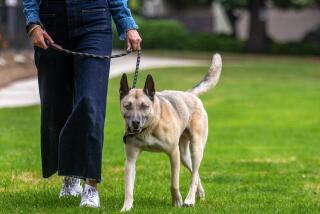THE OUTDOORS : Conning Retrievers : Because Most Dogs Would Rather Play Than Work, Norco Trainer Paddy Callaghan Makes a Game of It
For a golden retriever named Heather, it doesn’t get much better than this: Bounding through an open field on a sunny day, chasing make-believe birds, then bringing them back to be thrown again.
Doggie heaven.
“It’s hard to find a good golden that wants to work in the field because they’re bred for show dogs,” Pat (Paddy) Callaghan is saying as he watches the reddish-gold dog run through the mustard plant ground cover. “They’re not interested.”
But most dogs love to play, and that’s where Callaghan fools them. They think it’s a game. It is, too. Callaghan’s con game. Subtly, patiently, these dogs are really being trained.
“This dog was given to us about four months ago (as) a renegade,” says Callaghan, who owns Gameland Kennels in Norco, near Corona. “It wouldn’t do anything. Wouldn’t mind. (We were told) the dog was stupid, the dog was crazy, the dog’s dumb. Watch this.”
Tony Rojas, one of Callaghan’s trainers, attaches a short leash to Heather’s collar and starts walking. The dog heels obediently. Rojas stops. Heather sits. Then, without giving a command, Rojas walks backward. Heather backs up with him.
“Does that look like a dumb dog to you?” Callaghan says. “Smart as a whip. All it needed was some guidance.”
In 26 years, Callaghan claims, he has never met a dog he couldn’t train, at least to basic obedience.
“Haven’t seen one yet. Some take longer than others. For field work, the breeding tells an awful lot. All the dogs we take in for training, we let the owners know in 30 days if the dog’s going to be a hunting dog or not.”
Callaghan distinguishes between hunting, or gun, dogs and field trial dogs, which he worked for 17 years.
“We train gun dogs,” he says. “For field trials, you want ‘em to run as big and crazy as possible, because that’s what the judges are looking for. But it makes a tough dog to hunt with. A gun-dog man just wants an easygoing dog to produce birds for him.”
Some, by breeding, come to the training more naturally, but Callaghan says there are no real naturals.
“Some have more hunting instincts than others,” he says. “They all need a little work.”
The ideal age?
“We like to get ‘em 6 months and older,” he says. “We had one dog at 10 years.”
Given the breeding, a dog must overcome only one major obstacle--his owner.
“People are the hardest ones to work with, not the dogs,” Callaghan says.
Some expect too much.
“We have a gun-dog workshop that we take the owner through to teach him how to use the whistle and signals right, to correct the dog properly, proper use of the dog on land and water,” Callaghan says.
But if your dog is afraid of guns, forget it.
“If he’s gun-shy, he’s ruined,” Callaghan says--and he blames that on people, too.
“Gun-shy is a man-made thing. What man usually does is take a shotgun in his hand, take the dog in the other hand and go BANG! --and what’s this dog going to do?”
Leap out of his hide, probably.
“Right,” Callaghan says. “So the dog’s ‘gun-shy.’
“You can fix gun nervousness. That means if he hears a loud noise, he kind of spooks a little--’What was that loud noise?’ Gun-shyness is a dog that hears a gun and runs off or crawls under a table.”
Callaghan has his kennels at Raahauge’s Pheasant Hunting Club, whose 3,000 acres are divided by a green, marshy swath cut by the Santa Ana River. Callaghan, who lectures in three Western states for two dog-food companies, was conducting discussions and demonstrations at last weekend’s annual Shooting Sports Fair on the grounds.
Repeatedly, he preached his doctrine that a happy dog is the best dog.
“You do your field work first and your basic obedience goes in with it. The first thing you want to do is teach a young dog the willingness to retrieve--have fun, enjoy life. How can he do that when you’re jerking on his neck yelling ‘Heel! Heel! Heel!’?
“The last command we teach any dog is heel. “
Callaghan does not use the command stay, he said, because once a dog is told to stop, sit or lie down, until he is released by another command, stay is superfluous.
For whatever purpose he is training a dog, Callaghan starts with a month of evaluation and getting acquainted.
“People are always reading that if it’s a gun dog, it can’t be a family dog. We have a lot of people that don’t have gun dogs or don’t want it to be a gun dog. We have poodles, basset hounds, German shepherds, mutts. They want family dog obedience, and we feel that any gun dog should also be a family dog.
“What we do is get ‘em bird crazy, wanting to retrieve. The first command we teach is here-- to come back. Then we get ‘em running and turning in the field. If it’s a sitting dog, it’s taught to sit out there. That’s obedience, but all the time it’s over birds and he’s enjoying it.”
In his seminars Callaghan usually uses student dogs, not fully trained animals, to give them the experience of working amid distractions--in this instance, crowds of people, other dogs and constant gunfire from the ranges less than 100 yards away.
Occasionally, in a long seminar, he will borrow an untrained, undisciplined dog and work with it periodically during his lecture to make a point.
“I’ll completely train that dog in front of 1,500 or 2,000 people,” Callaghan said. “In three hours I’ll have that dog calm and sometimes working off the leash.”
The length of a training session varies with what Callaghan calls a dog’s “play drive” and attention span.
“Play drive is very important in keeping ‘em wanting to work. Stop and play with the dog for a couple of minutes. Work a little bit, you get to play. Later, when you need this dog to put in a little extra effort, you’ve got it.”
There is some psychology involved in training dogs. First, the handler must be smarter than the dog--and don’t laugh.
Callaghan’s fiancee, Shirley Molyneaux, explains: “Dogs run in packs, and there’s always a leader in the pack. They’re always trying to establish who the dominant leader is.
“In most (human) families, in (the dog’s) point of view, the family is the pack. If you tell your child no, he’ll test you. If you let him get away with it, he knows he can do it. A dog’s the same way. If the dog doesn’t mind, he is the dominant animal in the pack.”
So, who’s the leader--the one that barks loudest?
“You do not need to yell at any dog,” Callaghan says. “Once you yell, you’ve lost control of the animal, and the animal has control of you.”
Instead of yelling, Callaghan controls his dogs with subtle hand signals, short pips on a whistle or verbal commands just loud enough to be audible.
“We teach three languages,” he says.
A listener asks Callaghan from the audience about a dog that won’t let go of a bird once he retrieves it.
“That’s called freezing, “ Callaghan says. “And it’s caused by you.”
He explains that the animal, already uptight with the excitement of the hunt, becomes intimidated and confused.
“Most people stand erect, so to an animal that’s smaller, that’s being aggressive,” Callaghan says.
There is a simple solution. One is to back up to encourage the dog to follow you.
Then, Callaghan says, when the dog comes within reach, bend over quietly, “flip up an ear and blow in it. He’ll drop the bird.”
Rojas brings out a big, 10-month-old black Labrador named Bob.
“This is a young black Lab that we’re just steadying right now,” Callaghan says. “He’s been in training about three months.”
And, apparently, loving it.
Bob is let off the lead. “We’ve got to show this dog that we trust him,” Callaghan says. “Usually, he’ll perform quite well because he doesn’t want to break our trust.”
There is a 4-foot post set out in the field, with a watermelon stuck on top.
Nobody explains the watermelon, but Bob immediately figures out what the post is for. Time out.
Callaghan uses Bob to demonstrate how to teach a dog not to drop a bird before it’s supposed to. He grasps the dog’s lower jaw with his hand in the mouth and holds on, as Bob twists his head trying to get free.
“He can’t spit it out,” Callaghan says.
After about a minute, Bob stops struggling. Another minute later, he resumes, but the hand stays in his mouth. When he stops again, resigned, Callaghan lets go. Bob learns.
More to Read
Sign up for The Wild
We’ll help you find the best places to hike, bike and run, as well as the perfect silent spots for meditation and yoga.
You may occasionally receive promotional content from the Los Angeles Times.






